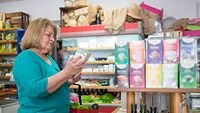Ensuring Greater Safety and Health for People Living with Food Allergies

Food is at the center of life. Whether it is preparing a simple meal, or it is part of a big celebration with family and friends, food plays a significant role in our global society. However, this everyday necessity can pose health and safety risks for individuals living with allergies. Even with the most cautious attention to foods, ingredients, and their labels, one mistake can have devastating effects for a person with food allergies, as well as their family members.
Unfortunately, food allergies are a global issue, and they are not abating. Researchers found that "the rate of food allergies worldwide has increased from around 3 percent of the population in 1960 to around 7 percent in 2018."1 According to a recent survey in the UK, 79 percent of respondents said they "know at least one person other than themselves that lives with allergies."2 In addition, hospital admissions for food-induced anaphylaxis have increased since the 1990s and mid-2000s in Australia, Spain, the UK, and the U.S.
With allergies and their health impacts on the rise, what can we do to help improve food safety and health?
There are two big game-changers for improving food allergen safety: more effective food labeling, as well as risk assessments to understand the severity and frequency of allergic reactions. To ultimately improve food labeling, scientists are working to establish allergen risk assessments to determine the relationship between the amounts of allergens and the proportion of individuals experiencing allergic reactions, as well as formulating thresholds for major food allergens.3 Identifying, prioritizing, and standardizing the list of major food allergens across global borders will help protect people everywhere living with allergies.
This research can also help food and beverage producers estimate how much of an allergen is present in a particular product. This, in turn, helps companies and producers understand allergen potency and how to manage an unexpected incident or an unintended presence of allergens in their products. These assessments also apply to whole supply chains to better plan for, and help prevent, risks from food allergens and possible exposure.
These assessments can be utilized to improve and standardize food labeling, as well. Many people shopping at their local market will look at labels on pre-packaged items to see what ingredients have been used and if any allergens are present. However, labeling, particularly around the presence of allergens, can be confusing.
Precautionary allergen labeling (PAL) was developed to mitigate food allergen risks at a time when they were almost completely uncharacterized and dominated by the fear of extreme allergic reactions. This lack of characterization has severely limited food choices for people living with multiple or severe allergies and celiac disease. Also, this type of labeling may create a public health risk because it is not always meaningful to consumers. In the U.S., food labels that say the product "may contain" an allergen are not always clear to people with allergies about whether or not the food is safe for them.4 Food and beverage producers should instead focus on making PAL more accurate, effective, and meaningful for consumers.
In fact, in the UK, the Food Standards Agency's Consultation on Precautionary Allergen Labeling found that the majority of consultation survey respondents (97 percent) support standardizing PAL.5 In addition, these labels are incredibly important; two out of three respondents "felt a product without a PAL would lead a consumer... to believe it was safe to eat." Furthermore, one in four respondents "said the consumer would not know whether [the product] was safe or not" without a PAL. Providing not just a PAL, but also more information about why a PAL is used on a product and standardizing those labels, can be significant for consumers.
For the past 20 years, ILSI Europe, a task force of nutrition and health experts in Europe, has been working collaboratively with critical stakeholders, from individuals with allergies to health care practitioners, to improve allergen risk assessments and management. Improving food labeling has been a crucial goal of this task force's work since it is virtually impossible to achieve zero risk from all allergens in food production processes. To promote more effective food labeling, this task force reviewed the relationship between exposure to an allergen and the proportion of people reacting, as well as the severity of those reactions, in order to provide a framework of evidence that health practitioners can use to advise patients about management of their allergy.6 In addition, food manufacturers and legislators can also reference the published research from this task force to make better decisions about managing allergens and precautionary labeling.7
Most recently, experts convened to better understand allergen cross-contact and unintended allergen presence in foods and beverages. As a result of this meeting, the group produced a guidance document8 that provides tools (such as a Contamination Estimate Calculator) and approaches to help harmonize data-gathering for food allergen risk assessments and aid in the implementation of these assessments, particularly by food producers and businesses, as well as governmental control agencies, patient organizations, clinicians and dietitians, among others.
While this work is still ongoing, a peer-reviewed article9 was recently published, and training videos are expected in the future to help stakeholders, including food and beverage producers, strengthen their support of the needs and perspectives of people living with food allergies.
A variety of foods are consumed every day, and someone living with a food allergy must conduct their own risk assessment each and every time they select a product. Experts, like the ones working with ILSI Europe's task force, aim to make the food selection process easier and, ultimately, improve the quality of life for people living with allergies. Stakeholders around the globe, from health care providers to those working in the food industry, should utilize this research to enhance their efforts in reducing the risks and adverse impacts of food allergens.10 Together, we can help give consumers with allergies greater confidence that their food is properly labeled and safe.
- Jones, Ralph. "Why food allergies are on the rise." BBC: Future. October 25, 2020. https://www.bbc.com/future/article/20201023-food-allergies-why-nut-dairy-and-food-allergy-are-rising.
- "Our Research." Allergy UK. 2021. https://www.allergyuk.org/its-time/our-research/.
- Dubois, A. E. J., P. J. Turner, J. Hourihane, et al. "How does dose impact on the severity of food-induced allergic reactions, and can this improve risk assessment for allergenic foods?" European Journal of Allergy and Clinical Immunology 73, no. 7 (January 13, 2018): 1383–1392. https://onlinelibrary.wiley.com/doi/10.1111/all.13405.
- Heid, Markham. "You Asked: Can I Trust Allergy Warnings on Food Labels?" Time. July 15, 2015. https://time.com/3957590/labels-food-allergies-warnings/.
- UK Food Standards Agency. "Precautionary Allergen Labelling (PAL) and Precautionary Allergen Information—The 'May Contain' Consultation: Report on Findings and Summary of Stakeholder Responses." May 2022. https://www.food.gov.uk/sites/default/files/media/document/PAL_Consultation%20report_Final_May%202022%201.pdf.
- Houben, Geert, Peter Burney, Chun-Han Chan, et al. "Prioritisation of allergenic foods with respect to public health relevance: Report from an ILSI Europe Food Allergy Task Force Expert Group." Food and Chemical Toxicology 89 (March 2016): 8–18. https://www.sciencedirect.com/science/article/pii/S0278691515301381.
- Madsen, Charlotte B., Myrthe W. van den Dungen, Stella Cochrane, et al. "Can we define a level of protection for allergic consumers that everyone can accept?" Regulatory Toxicology and Pharmacology 117 (November 2020): 104751. https://www.sciencedirect.com/science/article/pii/S027323002030177X.
- Remington, Benjamin C., Joseph Baumert, Marty W. Blom, et al. "Practical Guidance on the Application of Food Allergen Quantitative Risk Assessment." June 23, 2002. https://zenodo.org/record/6651934#.Yx-hfHbMI2x.
- Remington, Benjamin C., Joseph Baumert, Marty W. Blom, et al. "Allergen quantitative risk assessment within food operations: Concepts towards development of practical guidance based on an ILSI Europe workshop." Food Control 138 (August 2022): 108917. https://www.sciencedirect.com/science/article/abs/pii/S0956713522001104?via%3Dihub.
- ILSI Europe. "Publications." 2022. https://ilsi.eu/scientific-activities/food-safety/food-allergy/?v1=publications-new#publications1.
Looking for a reprint of this article?
From high-res PDFs to custom plaques, order your copy today!





